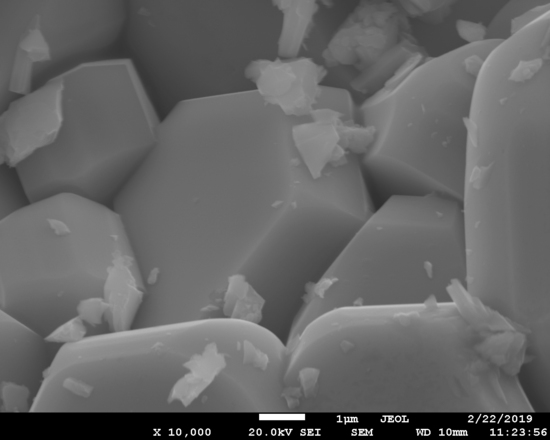Extremely Polysubstituted Magnetic Material Based on Magnetoplumbite with a Hexagonal Structure: Synthesis, Structure, Properties, Prospects
Abstract
1. Introduction
2. Materials and Methods
- -
- measuring S-parameters of the air-filled coaxial line with polystyrene rings;
- -
- measuring S-parameters of the material-filled coaxial line with polystyrene rings.
3. Results
3.1. Morphology and Chemical Composition
3.2. Crystal Structure
3.3. Electrodynamic Properies
4. Conclusions
Author Contributions
Funding
Conflicts of Interest
References
- Lin, M.I.; Tsai, M.H.; Shen, W.J.; Yeh, J.W. Evolution of structure and properties of multi-component (AlCrTaTiZr)Ox films. Thin Solid Films 2010, 518, 2732–2737. [Google Scholar] [CrossRef]
- Rost, C.M.; Sachet, E.; Borman, T.; Moballegh, A.; Dickey, E.C.; Hou, D.; Jones, J.L.; Curtarolo, S.; Maria, J.P. Entropy-stabilized oxides. Nat. Commun. 2015, 6, 8485. [Google Scholar] [CrossRef]
- Bérardan, D.; Franger, S.; Dragoe, D.; Meena, A.K.; Dragoe, N. Colossal dielectric constant in high entropy oxides. Rapid Res. Lett. 2016, 10, 328–333. [Google Scholar] [CrossRef]
- Sarkar, A.; Djenadic, R.; Usharani, N.J.; Sanghvi, K.P.; Chakravadhanula, V.S.K.; Gandhi, A.S.; Hahn, H.; Bhattacharya, S.S. Nanocrystalline multicomponent entropy stabilised transition metal oxides. J. Eur. Ceram. Soc. 2017, 37, 747–754. [Google Scholar] [CrossRef]
- Berardan, D.; Franger, S.; Meena, A.K.; Dragoe, N. Room temperature lithium superionic conductivity in high entropy oxides. J. Mater. Chem. A 2016, 4, 9536–9541. [Google Scholar] [CrossRef]
- Rak, Z.; Rost, C.M.; Lim, M.; Sarker, P.; Toher, C.; Curtarolo, S.; Maria, J.-P.; Brenner, D.W. Charge compensation and electrostatic transferability in three entropy-stabilized oxides: Results from density functional theory calculations. J. Appl. Phys. 2016, 120, 095105. [Google Scholar] [CrossRef]
- Rost, C.M.; Rak, Z.; Brenner, D.W.; Maria, J.-P. Local structure of the MgxNixCoxCuxZnxO(x = 0.2) entropy-stabilized oxide: An EXAFS study. J. Am. Ceram. Soc. 2017, 100, 2732–2738. [Google Scholar] [CrossRef]
- Berardan, D.; Meena, A.K.; Franger, S.; Herrero, C.; Dragoe, N. Controlled Jahn-Teller distortion in (MgCoNiCuZn)O-based high entropy oxides. J. Alloys Compd. 2017, 704, 693–700. [Google Scholar] [CrossRef]
- Sarkar, A.; Loho, C.; Velasco, L.; Thomas, T.; Bhattacharya, S.S.; Hahn, H.; Djenadic, R.R. Multicomponent equiatomic rare earth oxides with narrow band gap and associated praseodymium multivalency. Dalton Trans. 2017, 46, 12167–12176. [Google Scholar] [CrossRef]
- Djenadic, R.; Sarkar, A.; Clemens, O.; Loho, C.; Botros, M.; Chakravadhanula, V.S.K.; Kübel, C.; Bhattacharya, S.S.; Gandhi, A.S.; Hahn, H. Multicomponent equiatomic rare earth oxides. Mater. Res. Lett. 2017, 5, 102–109. [Google Scholar] [CrossRef]
- Lei, Z.; Liu, X.; Li, R.; Wang, H.; Wu, Y.; Lu, Z. Ultrastable metal oxide nanotube arrays achieved by entropy-stabilization engineering. Scr. Mater. 2018, 146, 340–343. [Google Scholar] [CrossRef]
- Dąbrowa, J.; Stygar, M.; Mikuła, A.; Knapik, A.; Mroczka, K.; Tejchman, W.; Danielewski, M.; Martin, M. Synthesis and microstructure of the (Co,Cr,Fe,Mn,Ni)3O4 high entropy oxide characterized by spinel structure. Mater. Lett. 2018, 216, 32–36. [Google Scholar] [CrossRef]
- Tsau, C.H.; Hwang, Z.Y.; Chen, S.K. The Microstructures and Electrical Resistivity of (Al,Cr,Ti)FeCoNiOx High-Entropy Alloy Oxide Thin Films. Adv. Mater. Sci. Eng. 2015, 2015, 353140. [Google Scholar] [CrossRef]
- Jiang, S.; Hu, T.; Gild, J.; Zhou, N.; Nie, J.; Qin, M.; Harrington, T.; Vecchio, K.; Luo, J. A new class of high-entropy perovskite oxides. Scr. Mater. 2018, 142, 116–120. [Google Scholar] [CrossRef]
- Sarkar, A.; Djenadic, R.; Wang, D.; Hein, C.; Kautenburger, R.; Clemens, O.; Hahn, H. Rare earth and transition metal based entropy stabilized perovskite type oxides. J. Eur. Ceram. Soc. 2018, 38, 2318–2327. [Google Scholar] [CrossRef]
- Meisenheimer, P.B.; Kratofil, T.J.; Heron, J.T. Giant Enhancement of Exchange Coupling in Entropy-Stabilized Oxide Heterostructures. Sci. Rep. 2017, 7, 13344. [Google Scholar] [CrossRef]
- Tsau, C.-H.; Yang, Y.-C.; Lee, C.-C.; Wu, L.-Y.; Huang, H.-J. The Low Electrical Resistivity of the High-entropy Alloy Oxide Thin Films. Procedia Eng. 2012, 36, 246–252. [Google Scholar] [CrossRef]
- Anand, G.; Wynn, A.P.; Handley, C.M.; Freeman, C.L. Phase stability and distortion in high-entropy oxides. Acta Mater. 2018, 146, 119–125. [Google Scholar] [CrossRef]
- Pullar, R.C. Hexagonal ferrites: A review of the synthesis, properties and applications of hexaferrite ceramics. Prog. Mater. Sci. 2012, 57, 1191–1334. [Google Scholar] [CrossRef]
- Zhang, W.; Peng, B.; Zhang, W.; Zhou, S.; Schmidt, H. Ultra large coercivity in barium ferrite thin films prepared by magnetron sputtering. J. Magn. Magn. Mater. 2010, 322, 1859–1862. [Google Scholar] [CrossRef]
- Xu, H.; Zhang, W.; Peng, B.; Zhang, W. Properties of barium hexa-ferrite thin films dependent on sputtering pressure. Appl. Surf. Sci. 2011, 257, 2689–2693. [Google Scholar] [CrossRef]
- Song, Y.-Y.; Ordóñez-Romero, C.L.; Wu, M. Millimeter wave notch filters based on ferromagnetic resonance in hexagonal barium ferrites. Appl. Phys. Lett. 2009, 95, 142506. [Google Scholar] [CrossRef]
- Harris, V.G. Modern microwave ferrites. IEEE Trans. Mag. 2012, 48, 1075–1104. [Google Scholar] [CrossRef]
- Cho, H.S.; Kim, S.S. M-Hexaferrites with planar magnetic anisotropy and their application to high-frequency microwave absorbers. IEEE Trans. Magn. 1999, 35, 3151–3153. [Google Scholar] [CrossRef]
- Matsumoto, M.; Miyata, Y.A. Gigahertz-range electromagnetic wave absorber with wide bandwidth of hexagonal ferrite. J. Appl. Phys. 1996, 79, 5486–5488. [Google Scholar] [CrossRef]
- Ghasemi, A.; Hossienpour, A.; Morisako, A.; Liu, X.; Ashrafizadeh, A. Investigation of the microwave absorptive behavior of doped barium ferrites. Mater. Des. 2008, 29, 112–117. [Google Scholar] [CrossRef]
- Zaitseva, O.V.; Vinnik, D.A.; Trofimov, E.A. The Poly-Substituted M-Type Hexaferrite Crystals Growth. Mater. Sci. Forum 2019, 946, 186–191. [Google Scholar] [CrossRef]
- Vinnik, D.A.; Klygach, D.S.; Zhivulin, V.E.; Malkin, A.I.; Vakhitov, M.G.; Gudkova, S.A.; Galimov, D.M.; Zherebtsov, D.A.; Trofimov, E.A.; Knyazev, N.S.; et al. Electromagnetic properties of BaFe12O19:Ti at centimeter wavelengths. J. Alloys Compd. 2018, 755, 177–183. [Google Scholar] [CrossRef]
- Trukhanov, S.V.; Trukhanov, A.V.; Turchenko, V.A.; Trukhanov, A.V.; Tishkevich, D.I.; Trukhanova, E.L.; Zubar, T.I.; Karpinsky, D.V.; Kostishyn, V.G.; Panina, L.V.; et al. Magnetic and dipole moments in indium doped barium hexaferrites. J. Magn. Magn. Mater. 2018, 457, 83–96. [Google Scholar] [CrossRef]
- Shannon, R.D.; Prewitt, C.T. Effective Ionic Radii in Oxides and Fluorides. Acta Cryst. Sect. B 1969, 25, 925–946. [Google Scholar] [CrossRef]
- Klygach, D.S.; Vakhitov, M.G.; Vinnik, D.A.; Bezborodov, A.V.; Gudkova, S.A.; Zhivulin, V.E.; Zherebtsov, D.A.; SakthiDharan, C.P.; Trukhanov, S.V.; Trukhanov, A.V.; et al. Measurement of permittivity and permeability of barium hexaferrite. J. Magn. Magn. Mater. 2018, 465, 290–294. [Google Scholar] [CrossRef]
- Knott, E.F. Dielectric constant of plastic foams. IEEE Trans. Antennas Propag. 1993, 41, 1167–1171. [Google Scholar] [CrossRef]
- Townes, W.D.; Fang, J.H.; Perrotta, A.J. The crystal structure and refinement of ferromagnetic barium ferrite, BaFe12O19. Z. Kristallogr. 1967, 125, 437–449. [Google Scholar] [CrossRef]
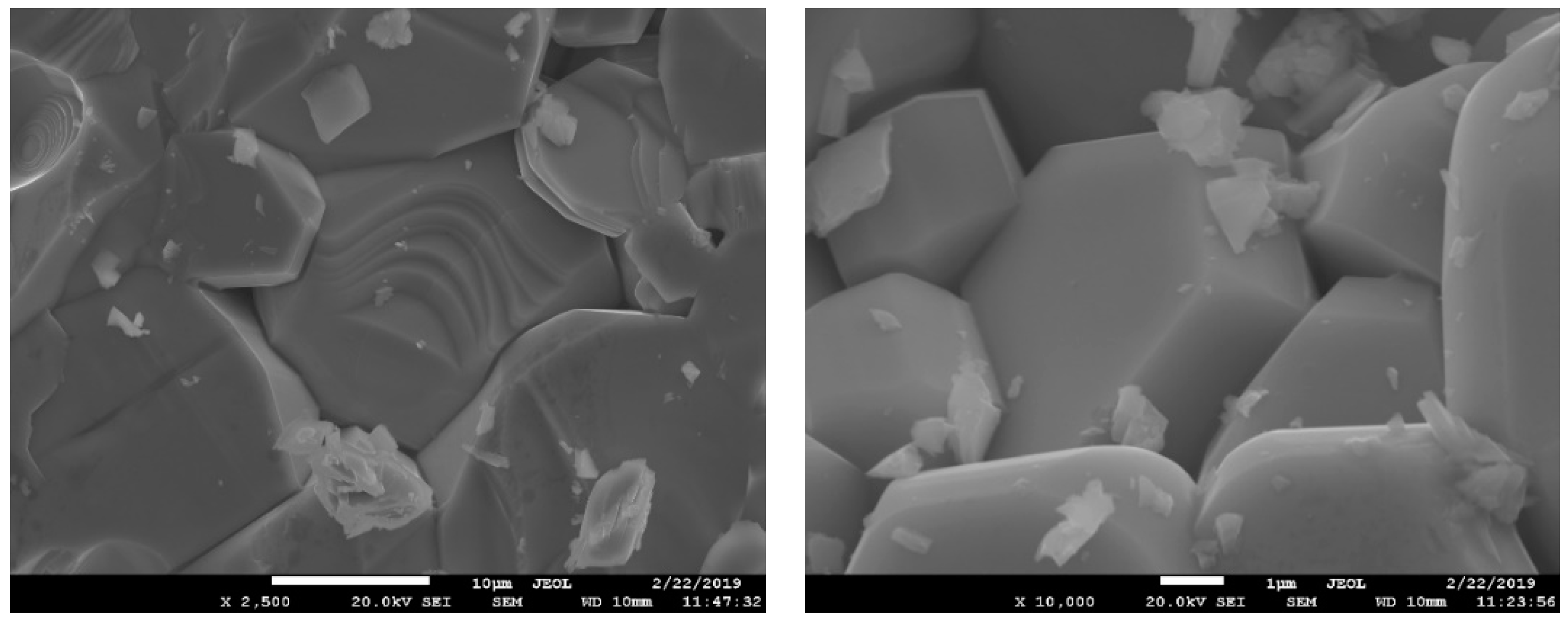
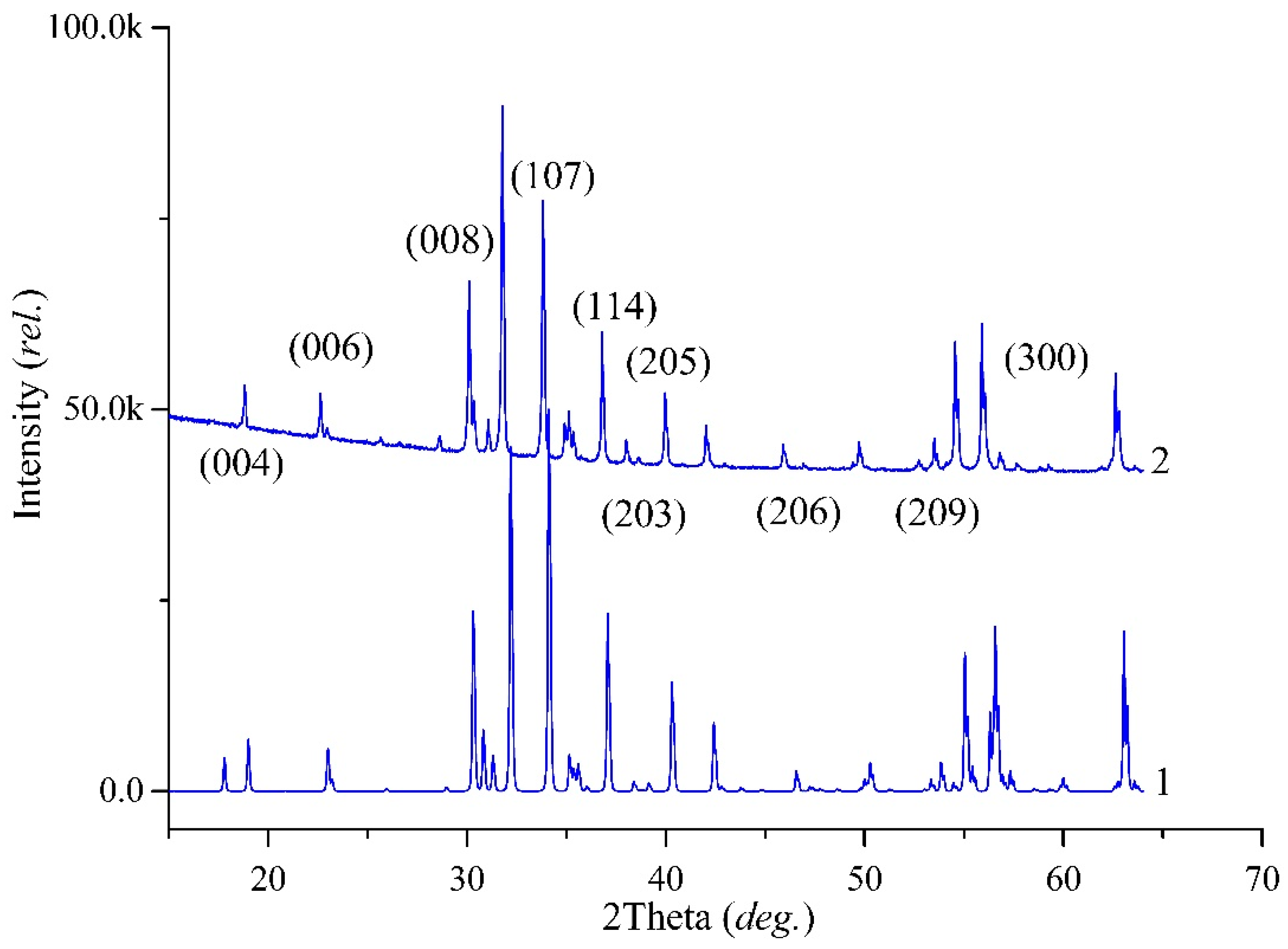
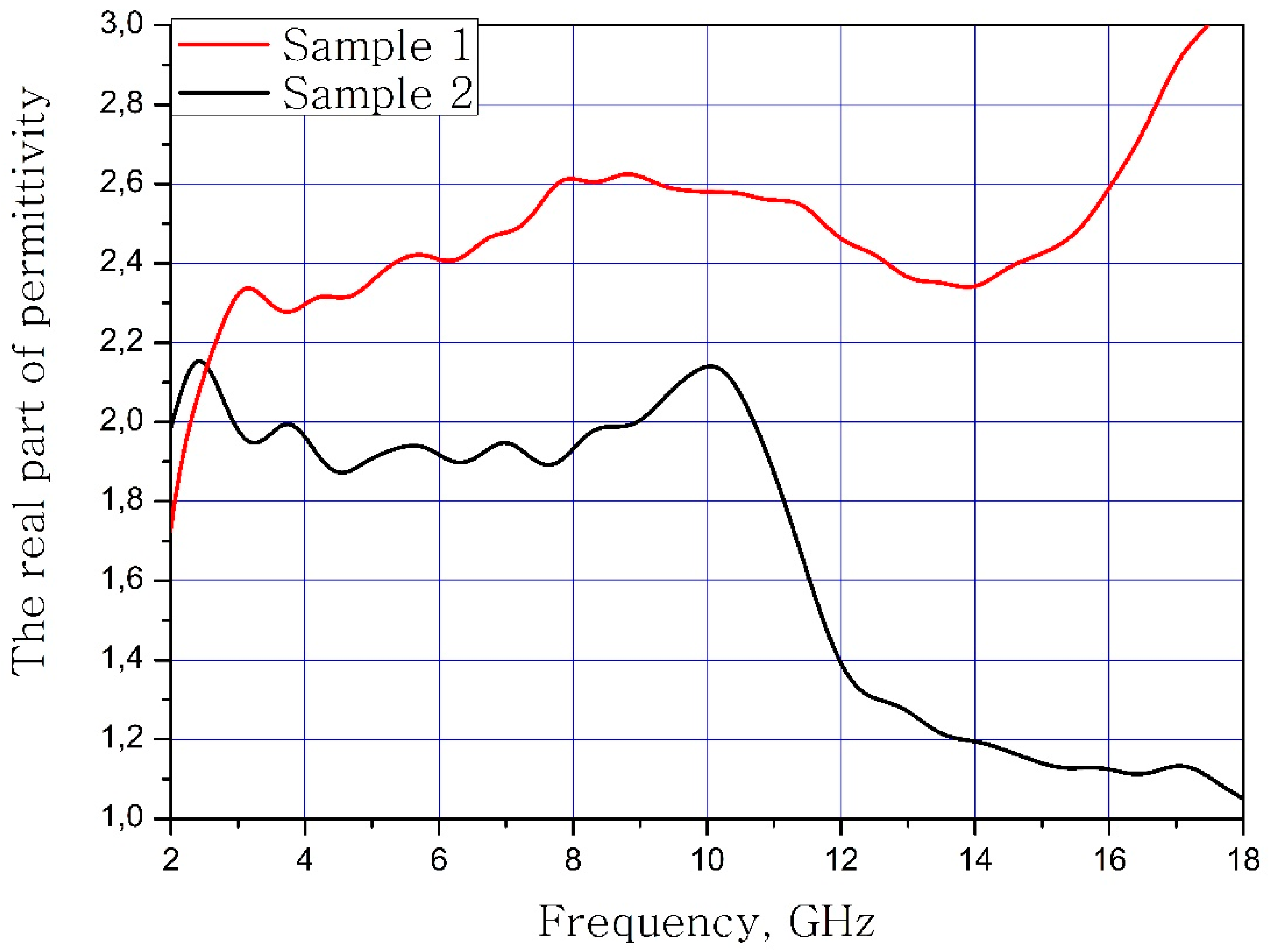
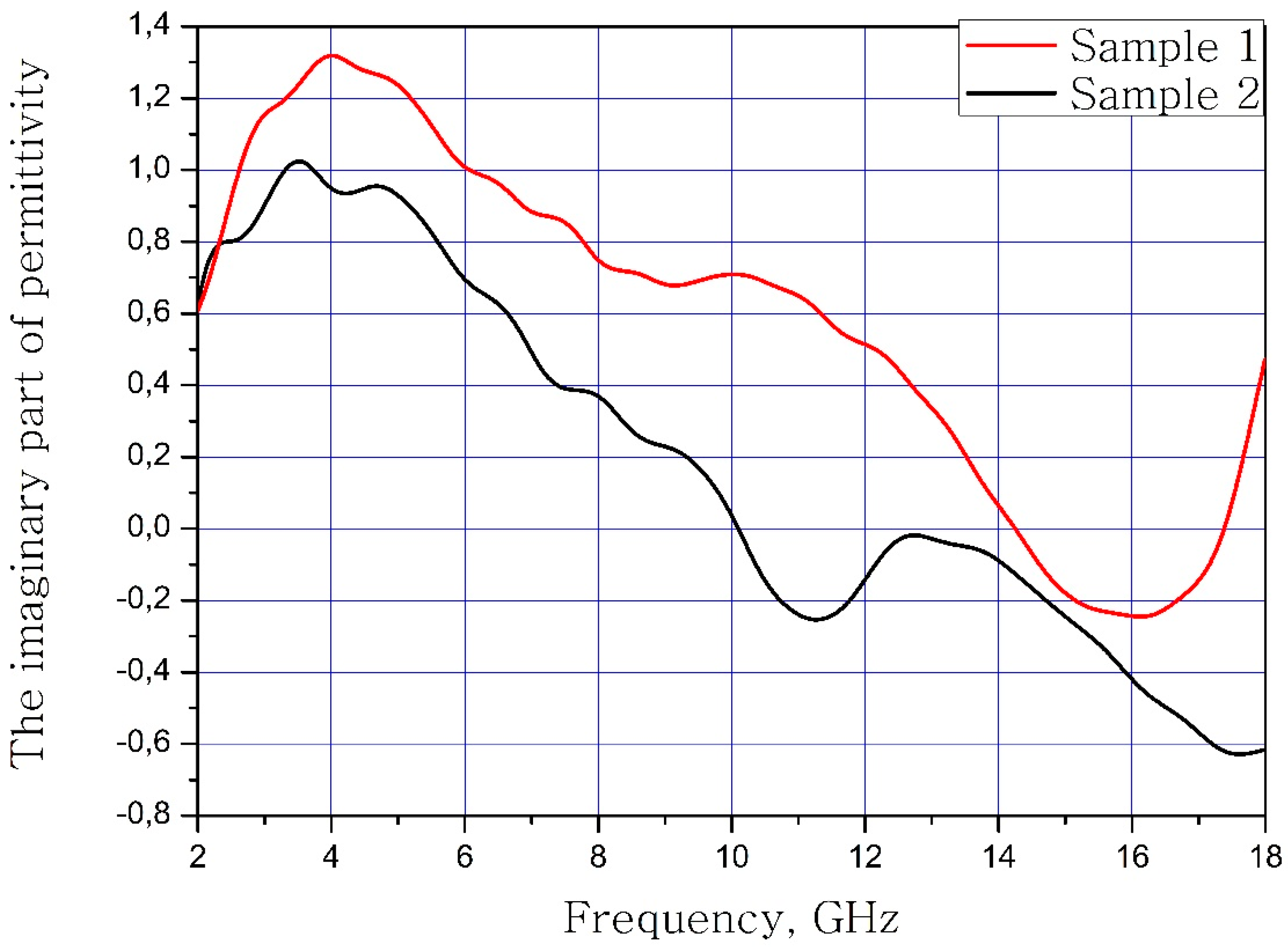
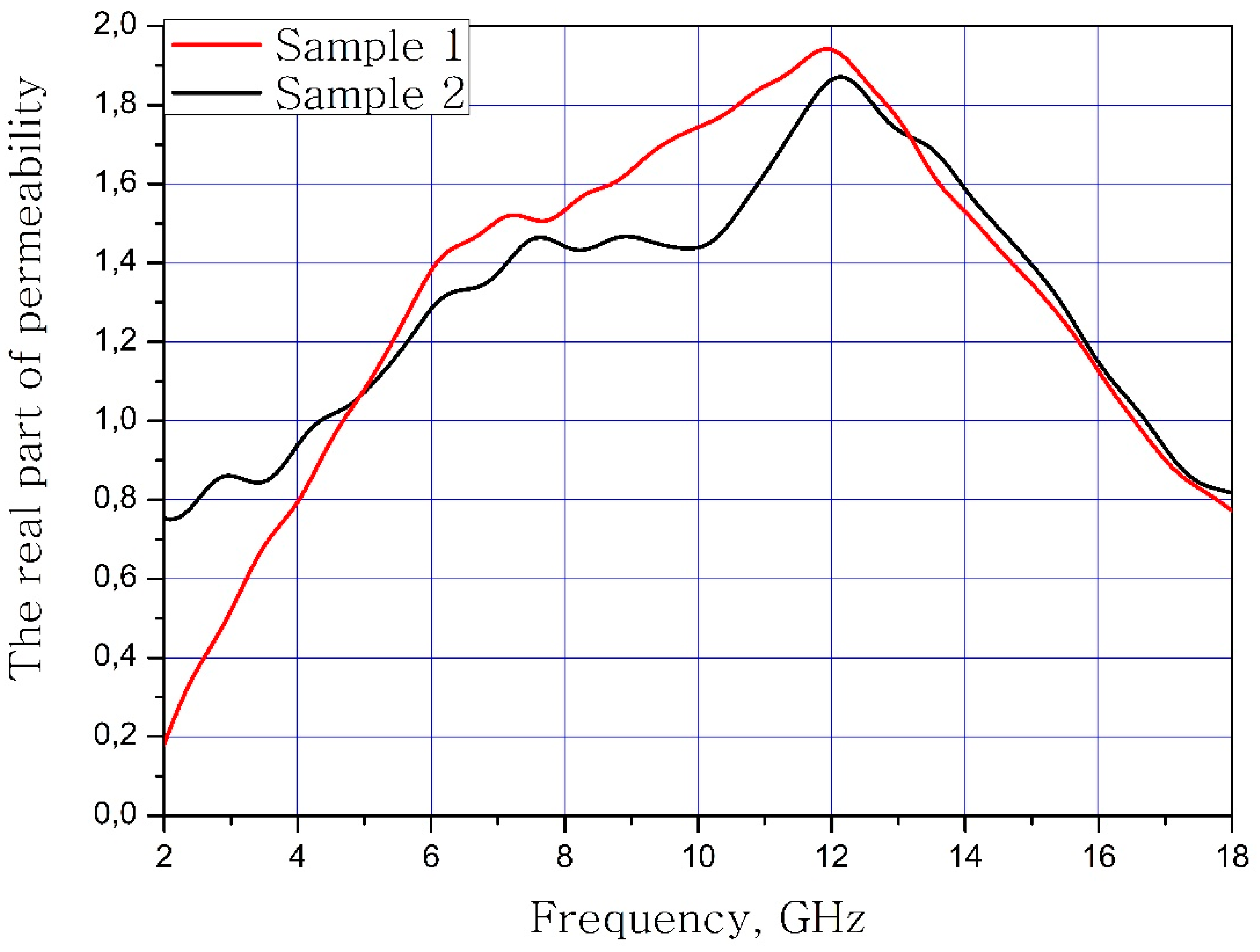
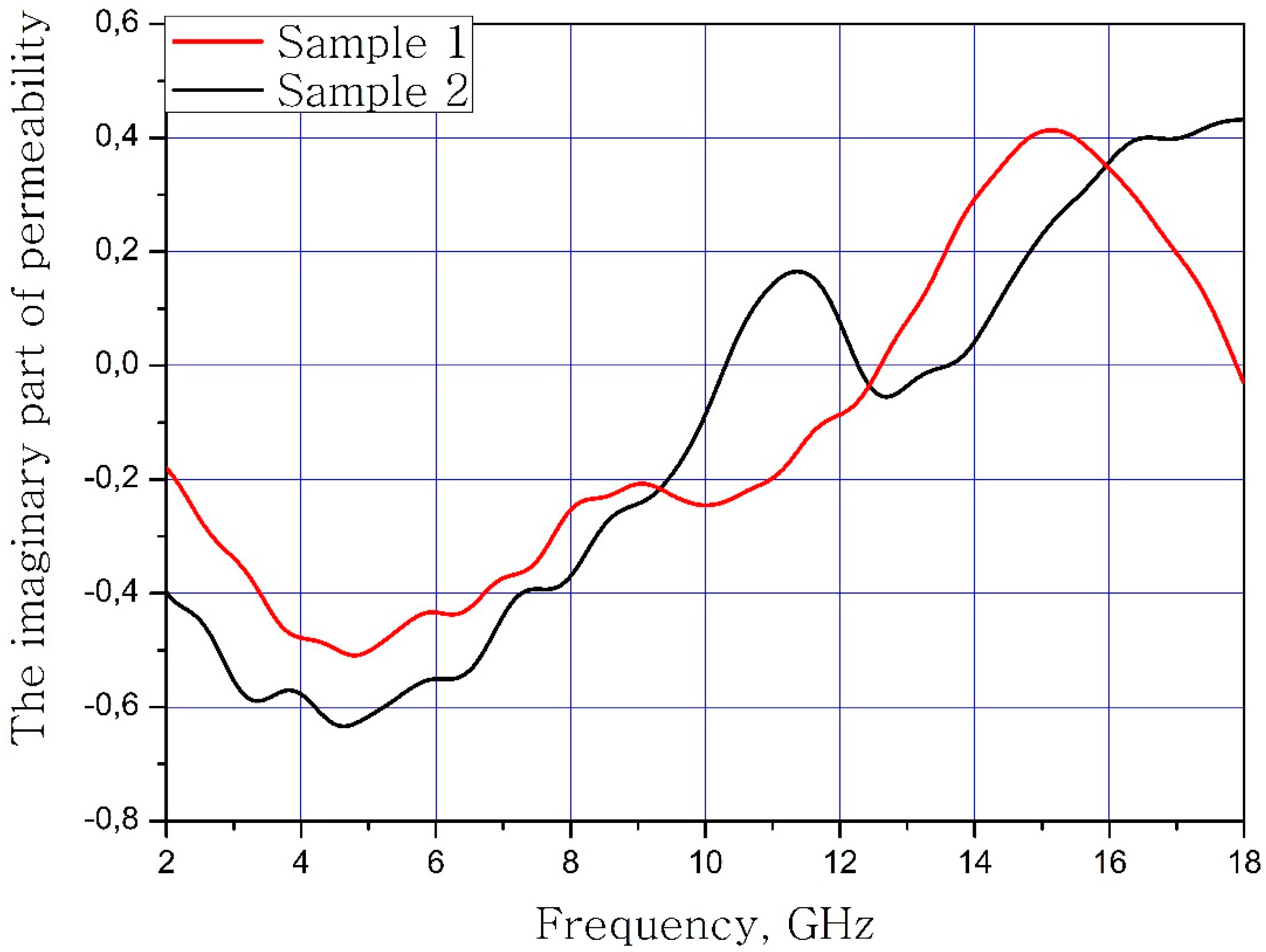
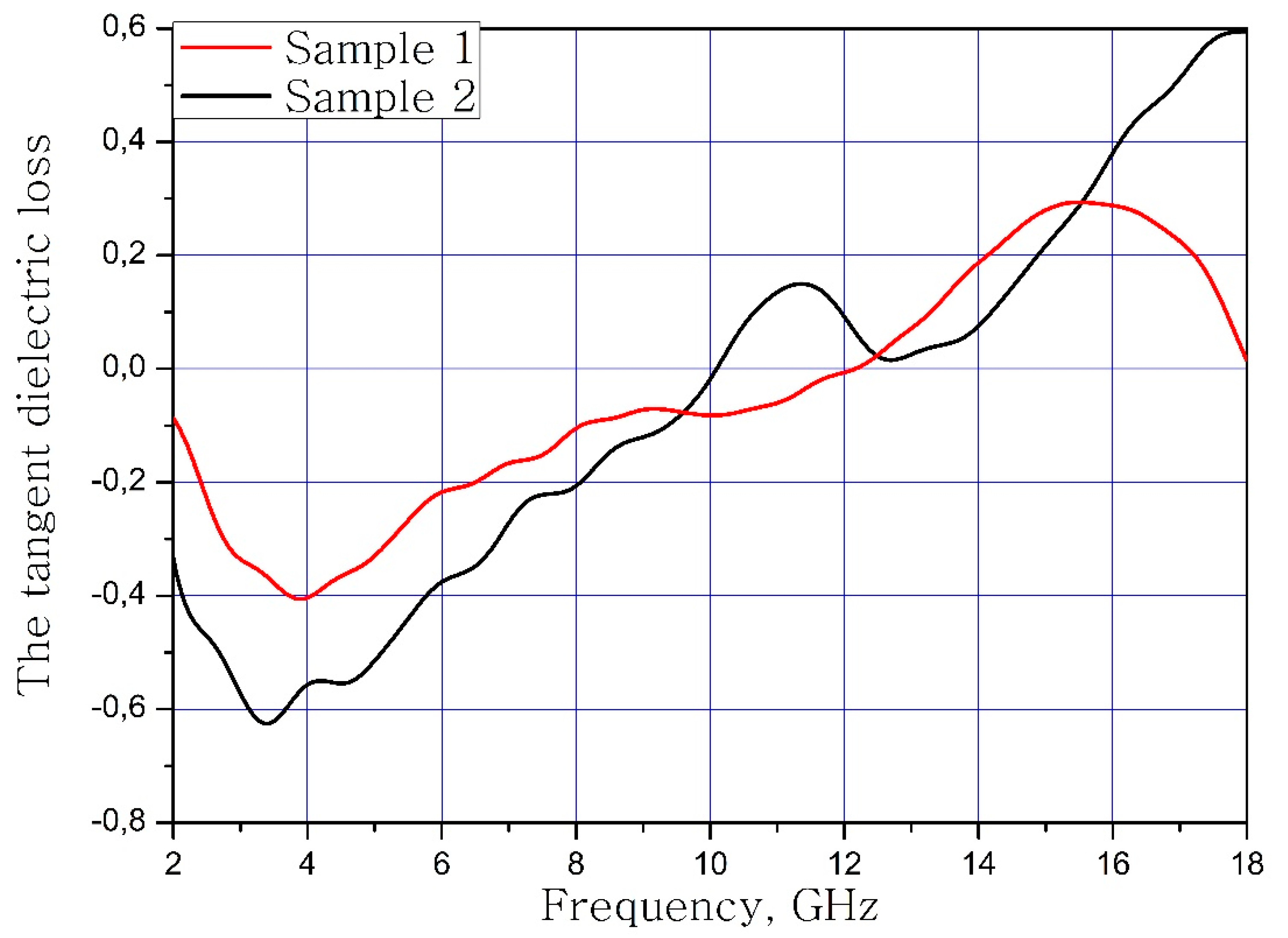
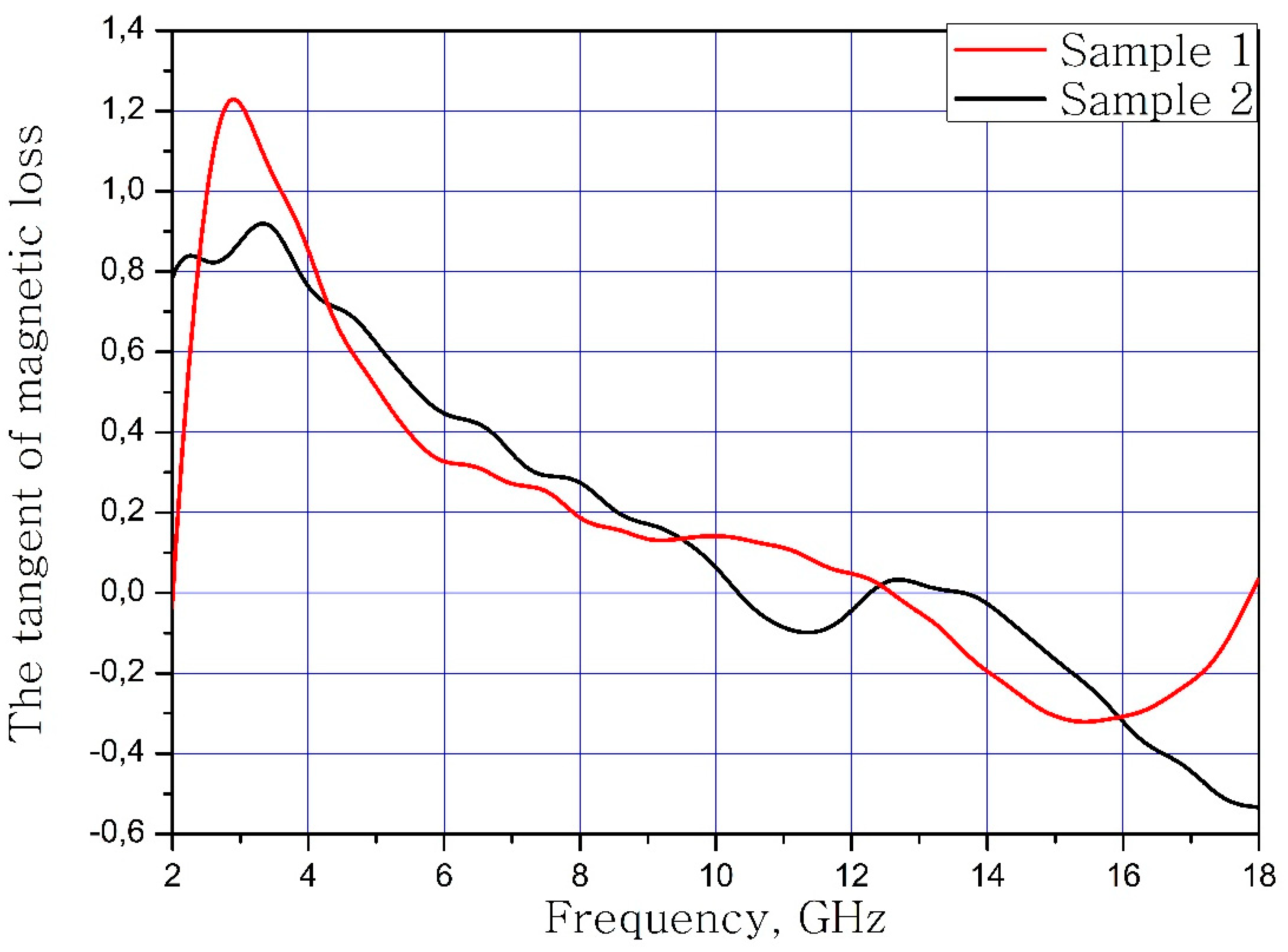
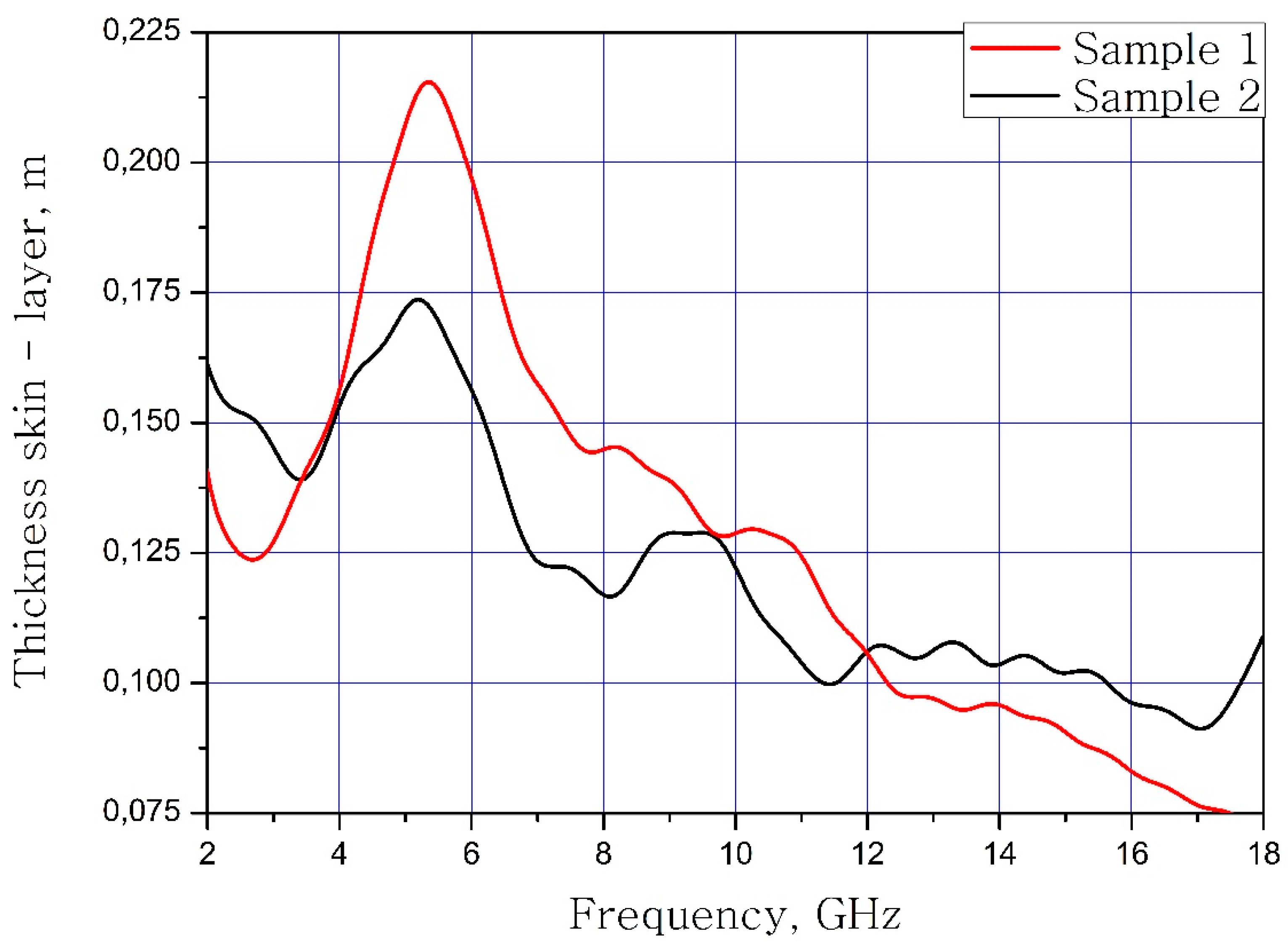
| B | In3+ | Ga3+ | Cr3+ | Fe2+ | Ti4+ | Fe3+ | Co3+ |
|---|---|---|---|---|---|---|---|
| ionic radii (pm) | 79 | 62 | 61.5 | 61/77 | 60.5 | 55/64.5 | 52.5/61 |
| # | Target Composition | BaCO3 | Fe2O3 | TiO2 | In2O3 | Ga2O3 | Cr2O3 | CoO |
|---|---|---|---|---|---|---|---|---|
| 1 | BaFe12O19 | 17.078 | 82.922 | - | - | - | - | - |
| 2 | Ba(Fe6Ga1.2In1.2Ti1.2Cr1.2Co1.2)O19 | 16.013 | 38.873 | 7.777 | 13.517 | 9.126 | 7.400 | 7.296 |
| # | Chemical Composition, wt. % | Sample Formula | ||||||
|---|---|---|---|---|---|---|---|---|
| Ba | Fe | Ti | In | Ga | Cr | Co | ||
| 1 | 3.36 | 38.90 | - | - | - | - | - | BaFe12O19 |
| 2 | 3.45 | 19.28 | 3.91 | 3.78 | 4.06 | 3.94 | 3.71 | Ba(Fe6Ga1.25In1.17Ti1.21Cr1.22Co1.15)O19 |
| No. | Synthesis Method | a [Å] | c [Å] | V [Å3] |
|---|---|---|---|---|
| [31] | BaFe12O19 | 5.893 | 23.194 | 697.5 |
| 1 | BaFe12O19 | 5.8922 (1) | 23.1953 (6) | 697.40 (2) |
| 2 | Ba(Fe6Ga1.25In1.17Ti1.21Cr1.22Co1.15)O19 | 5.9253 (5) | 23.5257 (22) | 715.32 (9) |
© 2019 by the authors. Licensee MDPI, Basel, Switzerland. This article is an open access article distributed under the terms and conditions of the Creative Commons Attribution (CC BY) license (http://creativecommons.org/licenses/by/4.0/).
Share and Cite
Vinnik, D.A.; Zhivulin, V.E.; Trofimov, E.A.; Starikov, A.Y.; Zherebtsov, D.A.; Zaitseva, O.V.; Gudkova, S.A.; Taskaev, S.V.; Klygach, D.S.; Vakhitov, M.G.; et al. Extremely Polysubstituted Magnetic Material Based on Magnetoplumbite with a Hexagonal Structure: Synthesis, Structure, Properties, Prospects. Nanomaterials 2019, 9, 559. https://doi.org/10.3390/nano9040559
Vinnik DA, Zhivulin VE, Trofimov EA, Starikov AY, Zherebtsov DA, Zaitseva OV, Gudkova SA, Taskaev SV, Klygach DS, Vakhitov MG, et al. Extremely Polysubstituted Magnetic Material Based on Magnetoplumbite with a Hexagonal Structure: Synthesis, Structure, Properties, Prospects. Nanomaterials. 2019; 9(4):559. https://doi.org/10.3390/nano9040559
Chicago/Turabian StyleVinnik, Denis A., Vladimir E. Zhivulin, Evgeny A. Trofimov, Andrey Y. Starikov, Dmitry A. Zherebtsov, Olga V. Zaitseva, Svetlana A. Gudkova, Sergey V. Taskaev, Denis S. Klygach, Maxim G. Vakhitov, and et al. 2019. "Extremely Polysubstituted Magnetic Material Based on Magnetoplumbite with a Hexagonal Structure: Synthesis, Structure, Properties, Prospects" Nanomaterials 9, no. 4: 559. https://doi.org/10.3390/nano9040559
APA StyleVinnik, D. A., Zhivulin, V. E., Trofimov, E. A., Starikov, A. Y., Zherebtsov, D. A., Zaitseva, O. V., Gudkova, S. A., Taskaev, S. V., Klygach, D. S., Vakhitov, M. G., Sander, E. E., Sherstyuk, D. P., & Trukhanov, A. V. (2019). Extremely Polysubstituted Magnetic Material Based on Magnetoplumbite with a Hexagonal Structure: Synthesis, Structure, Properties, Prospects. Nanomaterials, 9(4), 559. https://doi.org/10.3390/nano9040559






